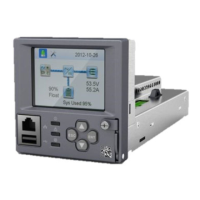Vertiv™ NetSure™ Control Unit (NCU) User Manual
High and Low Battery Temperature Alarms
The NCU can monitor battery temperature via a temperature sensor mounted on a battery cell. Values for high battery temperature
and low battery temperature alarms can then be programmed into the NCU.
Battery Thermal Runaway Management (BTRM) Feature
The Battery Thermal Runaway Management (BTRM) feature reduces voltage during a high battery temperature condition.
You can designate a temperature sensor as the BTRM sensor. The BTRM sensor has High 2 and High 1 BTRM temperature alarm
limits. If battery temperature exceeds the “BTRM Temp High 2” setting, system voltage is lowered to the BTRM voltage setting. This
feature can also be disabled.
Battery Discharge Test and Battery Test Logs
The NCU can perform battery discharge tests to check the condition of the battery(s). There are three (3) types of battery discharge
tests:
• Battery Test without Constant Current
• Battery Test with Constant Current
• Short Time Test (requires two battery shunts)
A User can manually start a battery discharge test or program the NCU to automatically start battery discharge tests at scheduled
intervals. Twelve (12) Constant Current Tests can be scheduled by the month-day-hour. A Short Time Test can be scheduled to be
performed every 1-365 days. During a battery discharge test, the NCU controls the rectifiers output to place the entire load or partial
load on the batteries. The NCU monitors the discharge of the battery and saves the results in a battery test log. The NCU stores ten
(10) battery discharge tests.
Functional Description:
For manual battery discharge tests as well as for scheduled battery discharge tests, the following parameters must be set: End Test
Voltage, End Test Time, and End Test Capacity. See Figure 1.4.
Figure 1.4 Battery Test Diagram
Battery Discharge Test Sequence:
• For a Constant Current Test, the output voltage of the rectifiers is reduced so that the batteries supply the preset Constant
Current Test Current to the load.
• If Constant Current is disabled, then the current being delivered by the batteries will be dependent on the load.
• For a Short Time Test, the output voltage of the rectifiers is reduced so that only the batteries power the load. If the batteries
fail, the rectifiers power the load.
• The battery test continues until one of the following occurs:
- The preset End Test Time, see Figure 1.4, expires. The battery has passed the test.
- The battery capacity drops below the preset End Test Capacity. The battery has passed the test.

